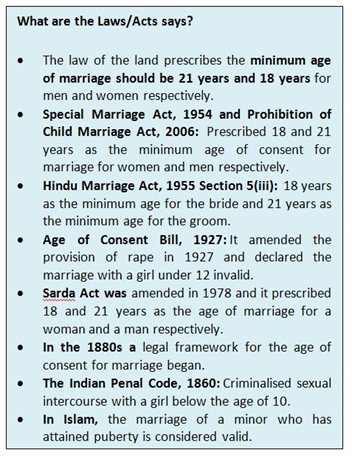

17th March 2023 (6 Topics)
Context
National Family Health Survey-5 (NFHS) data shows that higher education levels could play a greater role than wealth in delaying a woman’s marriage in today’s Indian Society.
Highlights of NFHS-5:
- The median marriage age of a woman who has completed over 11 years of schooling is 23 compared to 6 for a woman with less than five years of schooling.
- The data also reflect wide variations between the marital age of rural and urban women, and Dalit and upper-caste women.
- Social evils like the dowry system, poverty, and caste biases remained a major reason for girls fluctuating age of marriage.
Factors responsible for early marriages of girls in India:
- Poverty is the greatest determinant of early marriage.
- Societal barriers: It is believed that Marriage is a woman’s primary economic security.
- Lack of Literacy
- Norms associated with fertility
- Wrong perception of providing social security to daughters from societal offences than an unmarried woman.
Impacts of early marriages:
- Multiple diseases: The nutritional needs are high in late adolescence (15-19 years)and a fair measure of adolescent girls suffer from multiple forms of undernutrition, from chronic energy deficiency, and iron deficiency to micronutrient deficiency.
- Marriage and delivery during adolescence drain their already poor nutritional reserves and also lead to child stunting and mortality to multiple diseases at a later stage.
- The toll on mental health: Psychologically, women married as children are more likely to suffer from symptoms related to post-traumatic stress disorder (PTSD) and symptoms of depression.
- Low access to education: Marriage dramatically limits a girl’s access to education.
- Domestic violence: According to the International Council of Research On Women (ICRW), women with low levels of education and married adolescents between the ages of 15-19 years old are at a higher risk of domestic violence than older and more educated women.
Factors responsible for changing trends of marriage:
- To reduce maternal deaths: Increase in the marriageable age of girls will help in lowering maternal deaths and improving nutrition levels in the near term by putting more girls in college and enabling them to achieve greater financial independence in the long term.
- To keep the population in check: Helpful in controlling the population as it may help in keeping the population in check.
- Improved health: It would be helpful for Children’s health and Women’s overall development as the children who are born to mothers who tend to get married at an early age may develop health problems.
- Equality: Increasing the age of marriage will make the marriage age equal for both men and women.
- Women’s Health: Increasing the Marriage age can reduce Mortality Rates and can reduce the diseases like anaemia among them. (young mothers are more susceptible to anaemia)
- Enormous opportunities: Increasing women’s legal marriage age will give more power and legal support to all women so that they can choose the opportunities to educate and empower themselves, before being burdened with marriage and motherhood.
- Increased participation in the labour force: India will get a large labour force by increasing the marriageable age. In India Female labour force participation is too low compared to the world average.



